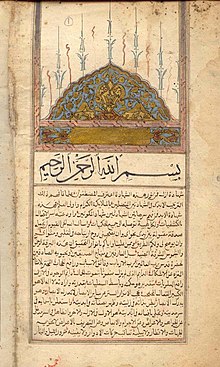Ahmad al-Buni
This article may require cleanup to meet Wikipedia's quality standards. (March 2010) |

| Part of a series on |
| Hermeticism |
|---|
 |
| Mythology |
|
Hermetic arts |
| Hermetic writings |
|
|
Related historical figures (ancient and medieval) |
|
|
Related historical figures (early modern) |
| Modern offshoots |
Ahmad ibn ‘Ali al-Buni (Arabic: أحمد البوني), also called Sharaf al-Din or Shihab al-Din Ahmad ibn Ali ibn Yusuf al-Buni al-Maliki al-ifriqi (born in Annaba, Algeria died 1225) was an Algerian[1] mathematician and philosopher and a well known Sufi and writer on the esoteric value of letters and topics relating to mathematics, sihr (sorcery) and spirituality, but very little is known about him. Al-Buni lived in Egypt and learned from many eminent Sufi masters of his time.[2]
A contemporary of Ibn Arabi,[3] he is best known for writing one of the most important books of his era; the Shams al-Ma'arif, a book that is still regarded as the foremost occult text on talismans and divination. It was to be banned soon after as heretical.
Contributions[]

Theurgy[]
Instead of sihr (Sorcery), this kind of magic was called Ilm al-Hikmah (Knowledge of the Wisdom), Ilm al-simiyah (Study of the Divine Names) and Ruhaniyat (Spirituality). Most of the so-called mujarrabât ("time-tested methods") books on sorcery in the Muslim world are simplified excerpts from the Shams al-ma`ârif.[4] The book remains the seminal work on Theurgy and esoteric arts to this day.
Mathematics and science[]
In c. 1200, Ahmad al-Buni showed how to construct magic squares using a simple bordering technique, but he may not have discovered the method himself. Al-Buni wrote about Latin squares and constructed, for example, 4 x 4 Latin squares using letters from one of the 99 names of Allah. His works on traditional healing remains a point of reference among Yoruba Muslim healers in Nigeria and other areas of the Muslim world.[5]
His influence[]
His work is said to have influenced the Hurufis and the New Lettrist International.[6]
Denis MacEoin in a 1985 article in Studia Iranica said that Al-Buni may also have indirectly influenced the late Shi'i movement of Babism. MacEoin said that Babis made widespread use of talismans and magical letters.[7]
Writings[]
- Shams al-Maʿārif al-Kubrā[8] (The Great Sun of Gnoses), Cairo, 1928.
- Sharḥ Ism Allāh al-aʿẓam fī al-rūḥānī, printed in 1357 AH or in Egypt al-Maṭbaʿa al-Maḥmudiyya al-Tujjariyya bi'l-Azhar.
- Kabs al-iktidā, Oriental Manuscripts in Durham University Library.
- Berhatiah, Ancient Magick Conjuration Of Power.
References[]
- ^ B. G. Martin, Muslim Brotherhoods in Nineteenth-Century Africa, Cambridge University Press, 2003, p.149
- ^ By C. J. Bleeker, G. Widengren, Historia Religionum, Volume 2 Religions of the Present, p.156,
- ^ Vincent J. Cornell, Realm of the Saint: Power and Authority in Moroccan Sufism, University of Texas Press, 1998, p. 221
- ^ Martin van Bruinessen, "Global and local in Indonesian Islam", Southeast Asian Studies (Kyoto) vol. 37, no.2 (1999), 46-63
- ^ Diagnosis through rosary and sand: Islamic elements in the healing custom of the Yoruba (Nigeria). Sanni A. Lagos State University, Nigeria
- ^ Shams al-Ma'arif al-Kubra ۞ The Sun of Great Knowledge.
- ^ Denis MacEoin, ‘Nineteenth-Century Babi Talismans’, Studia Iranica 14:1 (1985), pp.77-98.]
- ^ "Shams ul Maarif ul Kubra Urdu, شمس المعارف الکبریٰ, اردو, لطائف العوارف".
Notes[]
- Edgar W. Francis, Mapping the Boundaries between Magic. The Names of God in the Writings of Ahmad ibn Ali al-Buni
External links[]
- 1225 deaths
- 13th-century Arabs
- Algerian Sufis
- Magic squares
- Mathematicians of medieval Islam
- Medieval Egyptian mathematicians
- Medieval Arab mathematicians
- Muslim occultists
- Sufi writers
- People from Annaba
- 13th-century Moorish people
- Algerian emigrants to Egypt
- People from the Almohad Caliphate